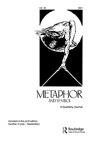Audience Perceptions of COVID-19 Metaphors: The Role of Source Domain and Country Context
IF 3.3
3区 文学
0 LANGUAGE & LINGUISTICS
引用次数: 5
Abstract
ABSTRACT Metaphors abound in descriptions of the COVID-19 pandemic: it is described, among other things, as a war, a flood, and a marathon. However, not all metaphors may resonate equally well with members of the public. Given that the pandemic has impacted people’s lives across countries in divergent ways – both in terms of spread and in terms of government-imposed measures, we investigated whether audience perceptions of metaphors for the COVID-19 pandemic depend on source domain and country context. This mixed-design study examined how individuals across three European countries (Germany, Italy, and The Netherlands) perceived different COVID-19 metaphorical frames. Participants (N = 216) were randomly exposed to nine metaphorical frames and one literal-language frame and asked to express their perceptions in terms of liking, aptness, complexity, conventionality, and credibility. Results showed that audience perceptions of metaphorical descriptions of the COVID-19 pandemic differed between source domains and country contexts, but mostly in terms of aptness. These findings suggest that experience with the target domain may indeed be relevant for metaphor perceptions and highlight the importance of studying metaphor appreciation as a multifaceted phenomenon. Findings may also inform metaphor choice by governments, journalists, and other actors to describe this novel situation.受众对COVID-19隐喻的认知:来源领域和国家背景的作用
关于COVID-19大流行的描述中充斥着隐喻:人们将其描述为战争、洪水和马拉松。然而,并不是所有的隐喻都能引起公众的共鸣。鉴于大流行以不同的方式影响了各国人民的生活——无论是在传播方面还是在政府实施的措施方面,我们调查了受众对COVID-19大流行隐喻的看法是否取决于来源领域和国家背景。这项混合设计研究调查了三个欧洲国家(德国、意大利和荷兰)的个人如何看待不同的COVID-19隐喻框架。参与者(N = 216)被随机暴露在9个隐喻框架和1个字面语言框架中,并被要求从喜欢、适宜、复杂、常规和可信度方面表达他们的看法。结果表明,受众对COVID-19大流行的隐喻性描述的看法因来源领域和国家背景而异,但主要是在适用性方面。这些发现表明,目标领域的经验可能确实与隐喻感知有关,并强调了将隐喻欣赏作为一种多面现象进行研究的重要性。研究结果还可以为政府、记者和其他行为者选择隐喻来描述这种新情况提供信息。
本文章由计算机程序翻译,如有差异,请以英文原文为准。
求助全文
约1分钟内获得全文
求助全文
来源期刊

Metaphor and Symbol
Multiple-
CiteScore
2.90
自引率
0.00%
发文量
23
期刊介绍:
Metaphor and Symbol: A Quarterly Journal is an innovative, multidisciplinary journal dedicated to the study of metaphor and other figurative devices in language (e.g., metonymy, irony) and other expressive forms (e.g., gesture and bodily actions, artworks, music, multimodal media). The journal is interested in original, empirical, and theoretical research that incorporates psychological experimental studies, linguistic and corpus linguistic studies, cross-cultural/linguistic comparisons, computational modeling, philosophical analyzes, and literary/artistic interpretations. A common theme connecting published work in the journal is the examination of the interface of figurative language and expression with cognitive, bodily, and cultural experience; hence, the journal''s international editorial board is composed of scholars and experts in the fields of psychology, linguistics, philosophy, computer science, literature, and media studies.
 求助内容:
求助内容: 应助结果提醒方式:
应助结果提醒方式:


